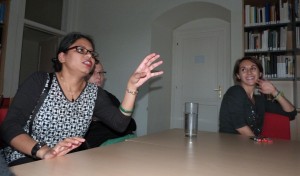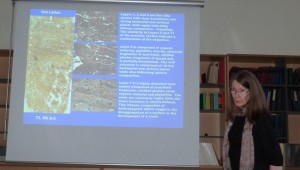Time flies by: AcrossBorders is by now already in its third year! Having just returned from a very successful season at Elephantine (thanks to our good cooperation with the Swiss Institute Cairo), I am more than happy that we just held a kick-off meeting in Vienna (Dec 8-9): Our new colleagues from the Charles McBurney Laboratory for Geoarchaeology in Cambrigde, Sayantani Neogi and Miranda Semple, joined us for two days of sharing information, ideas and thoughts about possible applications of micromorphology and geoarchaeology on Sai Island.
Microarchaeology, commonly applied to investigate formation processes on sites in Britain, Turkey and Syria (and very successfully by our colleagues working at Amara West), can provide astonishing results in uncovering human activities in seemingly insignificant traces within archaeological sections. Micromorphology and geochemistry will therefore be applied to investigate formation processes and cultural activities within the town site of Sai. Both anthropogenic activities and natural processes will be investigated by chemical analyses, petrographical studies and thin sections of archaeological deposits. There will be a particular focus on floors, walls and archaeological deposits within open areas.
Miranda is our new specialist for investigating activity areas and more in the different sectors of the Pharaonic town – the focus of her research will be on sampling contexts from our current excavation in SAV1 West.

Sayantani has conducted landscape archaeology in different parts of the world, e.g. in India and Spain.
Sayantani will concentrate on the landscape archaeology and the environmental setting of Sai Island during the 2nd millennium BC. For the upcoming season, sampling of relevant sections, drilling and test pits are planned as well as a detailed geoarchaeological survey in the area of the Pharaonic town and the New Kingdom cemeteries.
All of this will happen of course in close exchange with us working on the architecture, pottery, faunal remains and other finds.
I am much looking forward to our 2015 season and I am delighted that thanks to the strong interdisciplinary approach of AcrossBorders, the project is now applying multiple methods, including micro- and geoarchaeology with physical and chemical analyses of samples. This would not be possible without the support of several colleagues and here I am especially grateful to Charles French and his lab in Cambridge (Charles McBurney Laboratory for Geoarchaeology).


